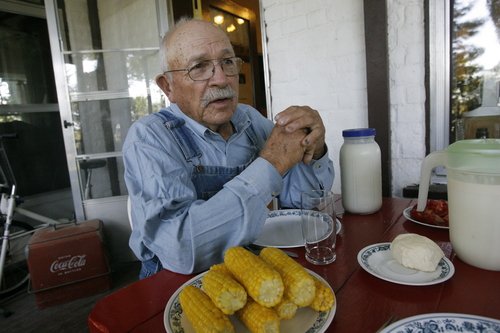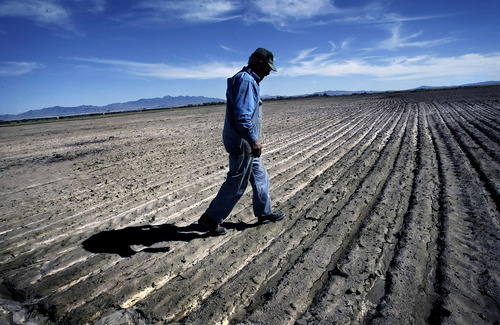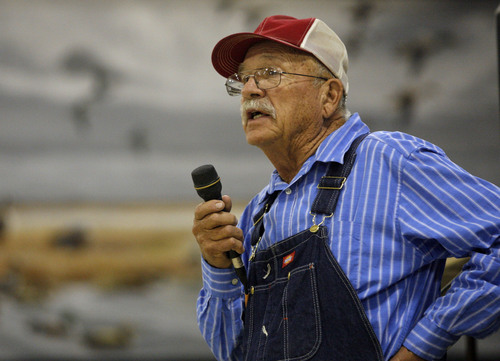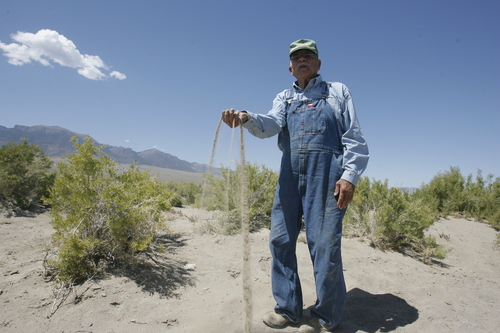This is an archived article that was published on sltrib.com in 2014, and information in the article may be outdated. It is provided only for personal research purposes and may not be reprinted.
For a guy who lived in the middle of nowhere, Cecil Garland had a way of being in the thick of things.
The rancher from outside of the west-desert hamlet of Callao was a leader in the 1979-1981 fight against the U.S. Air Force proposal to build the MX Missile System in the Great Basin valleys of eastern Nevada and western Utah. He also proved an intractable foe of the Southern Nevada Water Authority's efforts to take groundwater from beneath northeastern Nevada valleys and pipe it to Las Vegas.
Garland died Sunday at age 88 after a short bout with pneumonia.
President Ronald Reagan dumped the MX plan shortly after The Church of Jesus-Christ of Latter-day Saints came out against it in a famous statement on May 5, 1981.
The water battle is continuing, with many individual Utahns and government bodies (such as the Salt Lake County Council) supporting Garland's contention the Las Vegas "water grab" would dry out those already arid valleys, causing permanent drought and generating dust that would worsen Wasatch Front air pollution and damage the quality snowpack vital to the state's ski industry.
"He was a simple man but he did extraordinary things," Garland's widow, Annette, said Thursday in a telephone interview. "He felt he had a responsibility to protect the beautiful places, wildlife and the things that are sacred.
"Cecil was a religious man even though he didn't go to church," she added. "He believed he should always do his part and give back — and he did. A lot of people talk, but he did the things he thought he should do. He wasn't afraid to fight and stand up for the things he believed in."
Garland established a reputation for standing up even before moving to Utah in 1973.
Prior to that, when he lived in Montana, he was instrumental in creating the 240,000-acre Scapegoat Wilderness Area.
"That alone puts him in the category of other lions from the early days of the wilderness fight," said Steve Erickson, a Salt Lake City activist who met Garland in the MX days, teamed with him to fight the Air Force's later plan for an "electronic battlefield" in the west desert and continued to strategize with him until recently on thwarting Las Vegas's latest crusade for water.
"I think he would have preferred to be left alone to ranch and to contemplate the Deep Creeks [Mountains], but the government wouldn't leave him alone," Erickson said. "He was a reluctant fighter, but he relished a good fight."
Dan Lopp was working against the MX for the Western Action nonprofit organization when he met Garland at a meeting in Baker, Nev.
"He rallied a lot of the farmers and ranchers because he was an excellent speaker," Lopp recalled. "He had a down-home style of speaking, spoke slowly, and everyone listened to his words. He was also a great humorist, reminded me of Will Rogers."
One example: After hearing the Air Force laud the MX as the land portion of a three-mode approach to avoiding destruction from an attack by the Soviet Union, Garland suggested a fourth mode — a "commode."
"Everyone laughed," Lopp said, "but the serious message was very clear."
When it came to water, Garland observed, it was better used for "crops not craps."
Garland will be buried Friday in a pine coffin he built himself — "it's not fancy but it's the way he wanted it, just simple," Annette said — and that will contain mementos from his grandchildren.
On the weekend of Sept. 7, which would have been Garland's 89th birthday, a celebration of his life will take place in Callao. It will be held in conjunction with a meeting of the Great Basin Water Network, which will carry on Garland's fight to save the water.
"We'll tell stories and have a good time for a couple of days," Annette Garland said.
Twitter: @sltribmikeg —
Cecil Garland Jr.
1925-2014









